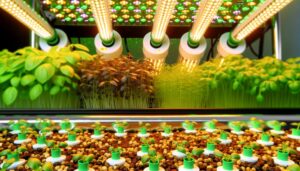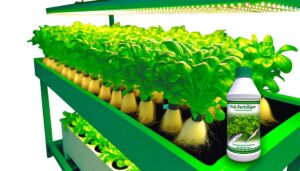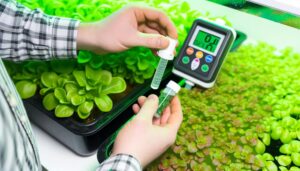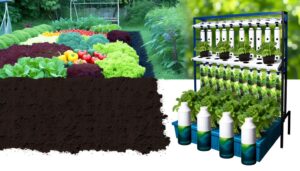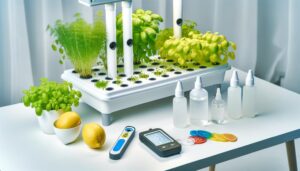How to Use Ec Meter Hydroponics
To effectively utilize an EC meter in hydroponics, start by calibrating the device with standard solutions to guarantee precision. Once calibrated, measure the electrical conductivity of your nutrient solution by immersing the electrode and recording the stabilized reading.
Ideal EC ranges vary by growth stage: seedlings (0.5-1.0 mS/cm), vegetative plants (1.0-1.5 mS/cm), and flowering or fruiting stages (1.5-2.5 mS/cm). Regular monitoring and adjustment are vital to prevent nutrient imbalances which can affect crop health.
Meticulous attention to these practices will greatly enhance plant growth and yield outcomes. Understanding advanced nuances and methods can further optimize your hydroponics system.
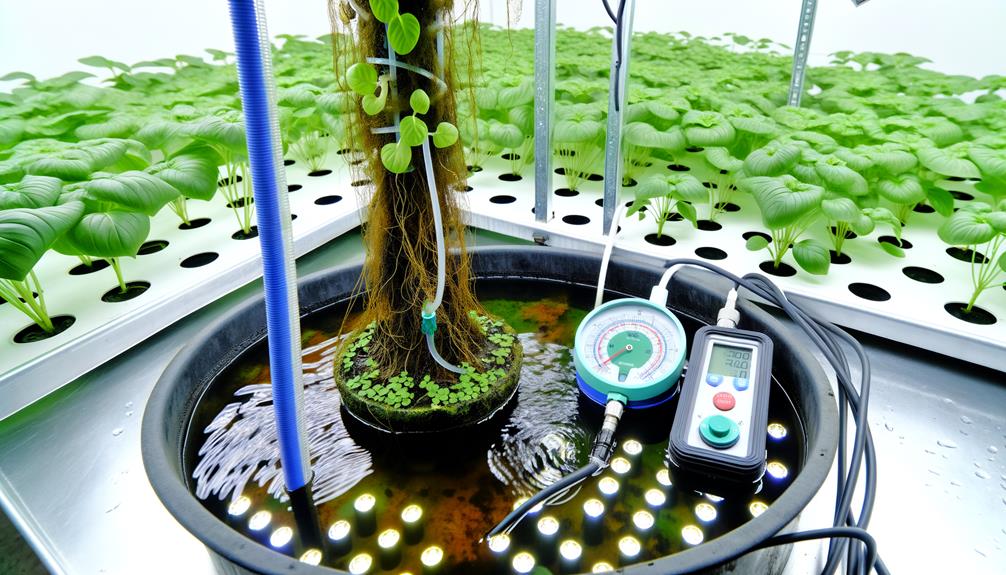
Key Takeaways
- Calibrate Regularly: Ensure accurate readings by calibrating your EC meter with standard solutions frequently.
- Measure Daily: Conduct daily EC measurements to monitor and maintain optimal nutrient levels for plant growth.
- Understand Ideal Levels: Adjust nutrient concentrations based on the specific EC requirements of different growth stages.
- Rinse Before Use: Always rinse the electrode with distilled water before and after measurements to maintain accuracy.
Understanding EC Meters
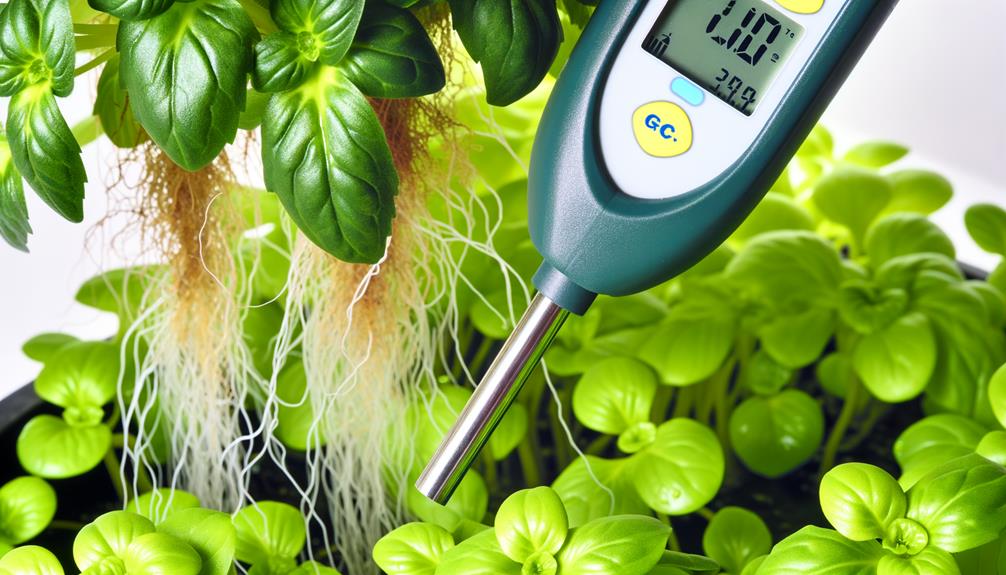
Understanding EC meters is essential for enhancing nutrient solutions in hydroponic systems, as they measure the electrical conductivity to guarantee proper nutrient concentrations.
Electrical conductivity (EC) gauges the ionic strength of a solution, reflecting the presence of dissolved salts, which represent nutrient availability.
EC meters consist of electrodes that detect the electrical current flow between them, providing a quantitative measurement typically expressed in microsiemens per centimeter (µS/cm) or millisiemens per centimeter (mS/cm).
Accurate calibration with standard solutions is imperative for ensuring precise readings.
These devices are indispensable for maintaining nutrient balance, ensuring that plants receive the ideal nutrient mix for robust growth.
Mastery of EC meter usage involves understanding its calibration, maintenance, and data interpretation to fine-tune nutrient formulations effectively.
Importance of EC in Hydroponics
Maintaining ideal electrical conductivity (EC) in hydroponics is critical for ensuring that plants receive the precise balance of nutrients required for optimal growth and development.
EC measurement directly correlates to the concentration of dissolved salts in the nutrient solution, indicating the overall nutrient availability. Accurate EC levels are essential to prevent nutrient imbalances, which can lead to deficiencies or toxicities, adversely affecting plant health and yield.
Furthermore, EC monitoring allows for the fine-tuning of nutrient formulations tailored to specific growth stages, enhancing the efficiency of nutrient uptake. Consistent EC levels also promote optimal osmotic conditions, facilitating water and nutrient absorption at the cellular level.
Consequently, diligent EC management is indispensable for maximizing the productivity of hydroponic systems.
Calibrating Your EC Meter

Calibrating your EC meter is critical for obtaining accurate measurements, necessitating the use of appropriate calibration solutions.
Selecting high-quality calibration solutions that match the expected conductivity range of your nutrient solution is paramount.
Adhering to precise calibration steps guarantees the reliability and reproducibility of your hydroponic system's data.
Calibration Solution Selection
Selecting the appropriate calibration solution is critical to guaranteeing the accuracy and reliability of your EC meter in hydroponic systems.
Calibration solutions, also known as standard solutions, are typically available at specific conductivity values, such as 1.41 mS/cm or 2.76 mS/cm. It's imperative to choose a solution that aligns with the expected range of nutrient concentrations within your hydroponic setup.
Utilizing a high-quality, traceable calibration solution guarantees precise calibration, thereby enhancing the reliability of EC readings.
Additionally, always verify the expiration date and storage conditions of the calibration solution to maintain its efficacy.
Consistent and accurate calibration is paramount for maintaining ideal nutrient balance and guaranteeing the overall health and productivity of your hydroponic plants.
Accurate Calibration Steps
To guarantee ideal performance of your EC meter, follow these precise calibration steps meticulously. Begin by rinsing the electrode with distilled water and gently blotting it dry. Prepare a fresh calibration solution with a known conductivity value. Immerse the electrode in the solution and wait for the reading to stabilize. Adjust the meter to match the solution's conductivity value, as specified by the manufacturer. Finally, rinse the electrode again with distilled water and store it appropriately.
| Step Number | Description |
|---|---|
| 1 | Rinse electrode with distilled water |
| 2 | Prepare and immerse in calibration solution |
| 3 | Adjust meter to match solution's conductivity |
Adhering to these steps guarantees your EC meter maintains accuracy and reliability, critical for ideal hydroponic nutrient management.
Measuring Nutrient Solution
To accurately measure the nutrient solution in hydroponics, it is essential to verify the EC meter is properly calibrated to assure precise readings. Regular calibration ensures that the readings remain consistent and reliable, preventing potential nutrient imbalances. In addition to an EC meter, using a TDS meter for hydroponics can help monitor total dissolved solids, providing further insight into the solution’s strength. Proper maintenance of these meters is crucial for optimizing plant growth and ensuring a balanced nutrient supply.
Understanding the ideal EC levels for different plant species allows for peak nutrient absorption, promoting robust growth and yield.
Adjusting the nutrient strength in response to EC measurements helps maintain a balanced solution, preventing deficiencies or toxicities that could impair plant health.
Calibration of EC Meter
Accurate calibration of an EC meter is paramount to guaranteeing precise measurement of the nutrient solution's electrical conductivity in hydroponic systems. Calibration should be conducted regularly to maintain measurement integrity.
Follow these steps:
- Prepare Calibration Solution: Use a high-quality EC standard solution, typically at 1.413 mS/cm, to guarantee accuracy.
- Clean the Probe: Rinse the probe with distilled water and gently blot dry to avoid contamination.
- Immerse and Stabilize: Submerge the probe in the calibration solution and allow the reading to stabilize.
- Adjust Calibration: Follow the manufacturer's instructions to adjust the meter to match the standard solution's EC value.
Ideal EC Levels
Once calibration is complete, understanding and maintaining the perfect EC levels in your nutrient solution is essential for ideal plant growth and health in hydroponic systems.
Electrical Conductivity (EC) measures the concentration of dissolved salts, indicating the nutrient strength of your solution. Ideal EC levels vary depending on plant species and growth stages; for instance, seedlings generally require 0.5-1.0 mS/cm, while mature plants might thrive at 1.5-2.5 mS/cm.
Deviations from these ranges can result in nutrient deficiencies or toxicities, impairing plant development. Regular monitoring guarantees that EC levels remain within the ideal range, preventing imbalances that could jeopardize crop yield and quality.
Employing a reliable EC meter is paramount for precise adjustments and maintaining hydroponic success.
Adjusting Nutrient Strength
Properly adjusting the nutrient strength of your hydroponic solution begins with accurately measuring its current Electrical Conductivity (EC) levels using a calibrated EC meter. This process guarantees plants receive ideal nutrient concentration for growth.
Follow these steps:
- Calibrate the EC Meter: Make sure your EC meter is properly calibrated to deliver precise readings.
- Obtain a Sample: Collect a representative sample of the nutrient solution for measurement.
- Measure the EC: Insert the EC meter into the sample and record the reading.
- Adjust Nutrient Levels: Compare the reading to ideal EC ranges for your specific crops. If adjustments are necessary, add more nutrient solution or dilute with water accordingly.
Precise EC management is vital for maintaining nutrient balance and fostering ideal plant health.
Interpreting EC Readings
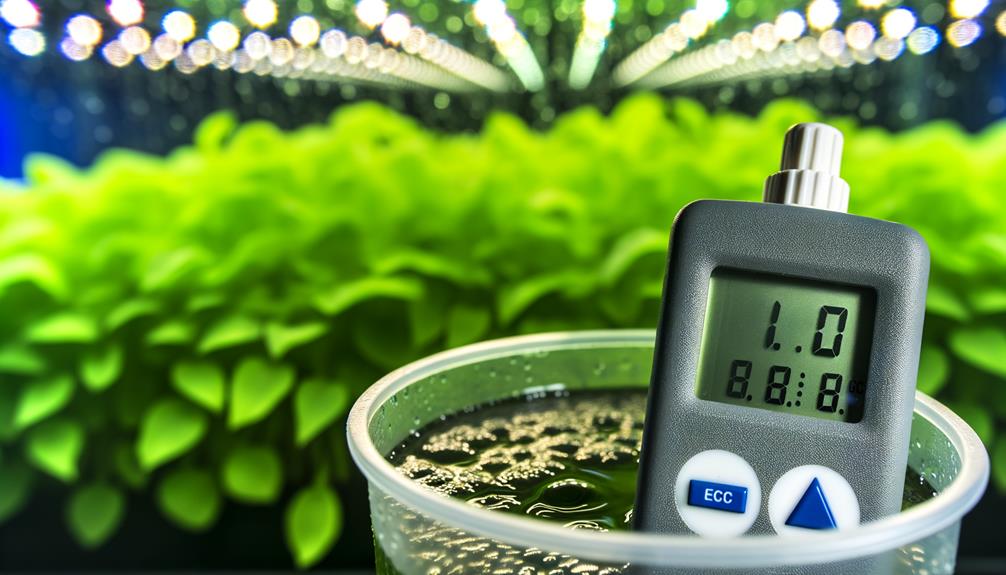
Interpreting EC readings involves understanding the specific electrical conductivity values that correlate with ideal nutrient concentrations for different stages of plant growth in hydroponic systems.
Electrical Conductivity (EC) is a direct indicator of the total ionic content within the nutrient solution.
Seedlings typically require an EC of 0.5-1.0 mS/cm, while vegetative stages benefit from 1.0-1.5 mS/cm. During flowering or fruiting, levels may need to be adjusted to 1.5-2.5 mS/cm.
Deviations from these ranges can lead to nutrient imbalances, potentially causing deficiencies or toxicities.
Accurate interpretation necessitates frequent monitoring and an understanding of the crop-specific requirements.
Utilizing an EC meter effectively guarantees prime nutrient availability, promoting robust growth and maximizing yield potential.
Maintaining Optimal EC Levels
To maintain ideal EC levels, it is imperative to conduct regular checks and adjustments to the nutrient solution, making sure it aligns with the specific growth stage requirements of the plants. Consistent monitoring and fine-tuning are essential for enhancing plant health and yield.
Here are key steps to achieve this:
- Measure EC Daily: Conduct daily EC measurements using a reliable EC meter to promptly detect deviations.
- Adjust Nutrient Concentration: Modify the nutrient solution concentration based on EC readings to make certain nutrient availability is at its best.
- Calibrate Equipment: Regularly calibrate the EC meter to maintain measurement accuracy.
- Document Readings: Keep a detailed log of EC measurements and adjustments to track trends and anticipate needs.
Employing these practices will facilitate maintaining ideal EC levels, promoting robust plant development.
Conclusion
In summation, mastering the use of an EC meter is paramount for enhancing hydroponic systems.
By understanding calibration, measurement protocols, and interpretation of readings, one can maintain nutrient solutions at ideal levels.
What could be more rewarding than the assurance of precise nutrient management leading to robust plant growth?
Through meticulous attention to electrical conductivity, cultivators can achieve unparalleled efficiency and productivity in their hydroponic endeavors.


